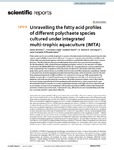Mostrar o rexistro simple do ítem
Unravelling the fatty acid profiles of different polychaete species cultured under integrated multi-trophic aquaculture (IMTA)
| dc.contributor.author | Jerónimo, Daniel | |
| dc.contributor.author | Lillebø, Ana Isabel | |
| dc.contributor.author | Maciel, Elisabete | |
| dc.contributor.author | Domingues, M. Rosário M. | |
| dc.contributor.author | Cremades, Javier | |
| dc.contributor.author | Calado, Ricardo | |
| dc.date.accessioned | 2021-09-23T11:00:31Z | |
| dc.date.available | 2021-09-23T11:00:31Z | |
| dc.date.issued | 2021-05-24 | |
| dc.identifier.citation | Jerónimo, D., Lillebø, A.I., Maciel, E. et al. Unravelling the fatty acid profiles of different polychaete species cultured under integrated multi-trophic aquaculture (IMTA). Sci Rep 11, 10812 (2021). https://doi.org/10.1038/s41598-021-90185-8 | es_ES |
| dc.identifier.issn | 2045-2322 | |
| dc.identifier.uri | http://hdl.handle.net/2183/28510 | |
| dc.description.abstract | [Abstract] Polychaetes can be successfully employed to recover otherwise wasted nutrients present in particulate organic matter (POM) of aquaculture effluents. The present study describes the fatty acid (FA) profile of four different polychaete species cultured in sand filters supplied with effluent water from a marine fish farm. The FA profile of cultured and wild Hediste diversicolor was compared and revealed a ≈ 24.2% dissimilarity, with cultured biomass displaying a higher content in two essential n-3 highly unsaturated FA (HUFA) (EPA [20:5 n-3] and DHA [22:6 n-3]—eicosapentaenoic and docosahexaenoic acid, respectively). The comparison of the FA profile of cultured H. diversicolor with that of other polychaete species whose larvae successfully settled on the sand filters (Diopatra neapolitana, Sabella cf. pavonina and Terebella lapidaria) revealed that their FA profile, which is here described for the first time, displayed high levels of EPA and DHA (≈ 1.5–4.8 and 1.0–1.1 µg mg−1 DW, respectively). The highest concentration of total FA per biomass of polychaete was recorded in H. diversicolor and T. lapidaria, with both species being the ones whose FA profiles revealed a lowest level of dissimilarity and more closely resembled that of the aquafeed used in the fish farm. In the present work it was demonstrated that it is possible to produce polychaetes biomass with high nutritional value through an eco-design concept such as integrated multi-trophic aquaculture (IMTA). Indeed, this framework promotes a cleaner production and, in this specific case, allowed to recover essential fatty acids that are commonly wasted in aquaculture effluents. | es_ES |
| dc.description.sponsorship | European Commission; MAR-02.01.01-FEAMP-0038 | es_ES |
| dc.description.sponsorship | European Commission; Centro-01-0145-FEDER-000018 | es_ES |
| dc.description.sponsorship | Portugal. Fundação para a Ciência e a Tecnologia; PD/BD/127989/2016 | es_ES |
| dc.description.sponsorship | Portugal. Centro de Estudos do Ambiente e do Mar; UIDB/50017/2020 | es_ES |
| dc.description.sponsorship | Portugal. Centro de Estudos do Ambiente e do Mar; UIDP/50017/2020 | es_ES |
| dc.language.iso | eng | es_ES |
| dc.publisher | Springer Nature | es_ES |
| dc.relation.uri | https://doi.org/10.1038/s41598-021-90185-8 | es_ES |
| dc.rights | Atribución 3.0 España | es_ES |
| dc.rights.uri | http://creativecommons.org/licenses/by/3.0/es/ | * |
| dc.title | Unravelling the fatty acid profiles of different polychaete species cultured under integrated multi-trophic aquaculture (IMTA) | es_ES |
| dc.type | info:eu-repo/semantics/article | es_ES |
| dc.rights.access | info:eu-repo/semantics/openAccess | es_ES |
| UDC.journalTitle | Scientific Reports | es_ES |
| UDC.volume | 11 | es_ES |
| UDC.startPage | 10812 | es_ES |






